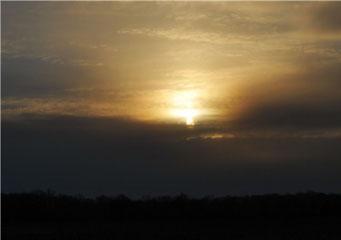
Above: Stratus Translucidus
Stratus Translucidus
Stratus translucidus clouds refer to one of the three varieties of stratus clouds. The other two are stratus opacus and stratus undulatus. Generally, stratus clouds are low-level clouds which have a base that is uniform throughout and are layered horizontally. They come in gray, light gray to almost white color. They are also flat, monotonous and featureless expanding in the sky like sheets. They appear in the sky during a cloudy day and may produce a little drizzle and bring about snow grains. Only in extremely cold weather that these clouds produce some snow.
How do stratus translucidus clouds look like?
Stratus translucidus clouds are characterized by its veil-like features and are thinly spread out in the sky such that the moon or the sun is still recognizable. These features of stratus translucidus are in contrast with the characteristics of stratus opacus which are compact, thus, hiding the moon or the sun completely. Being a variety of stratus clouds, the species of the parent cloud namely stratus fractus and stratus nebulosus may take its form or the form of other varieties such as stratus fractus opacus, stratus fractus nebulosus or stratus fractus translucidus.
Classification of stratus translucidus clouds
Stratus translucidus clouds are part of the category of stratiform clouds, its name derived from the Latin word strato which means sheet. Its parent clouds are called stratus clouds which belong to family of low level clouds along with cumulus clouds. Under stratus clouds are two species which are called stratus fractus and stratus nebulosus, the former having a ragged appearance while the latter looking like fog. Furthermore, stratus clouds have three varieties which are stratus translucidus, stratus opacus and stratus undulatus. This means that the stratus cloud species may be classified under these three varieties depending on their appearance.
Where can I see stratus translucidus clouds?
Stratus translucidus clouds commonly appear during a cloudy day. Being low-lying clouds, they can appear low and at a height below 2000 meters or 6500 feet. As such, they are the clouds which are the most seen by people. Stratus translucidus clouds, like any other species or varieties of stratus clouds, usually form when a fog is lifted higher in the sky in the morning. They are formed in precipitation or stable air mass conditions so they can be seen mostly looming over mountains, oceans and seas.
How are stratus translucidus clouds formed?
The formation of stratus clouds, of which stratus translucidus clouds belong, is basically the same. There are two cooling process by which they are formed called advective or radiative cooling. These two processes differ in how the air mass which eventually turn into the cloud are cooled. In advective cooling, the air mass is cooled because it moves from a warm surface to a cooler one. In radiative cooling, it is radiation that causes the cooling.
The process basically follows the following steps:
- When a large air mass is formed and passes through a warm sea surface, said air mass is warmed and collect water vapor.
- The warmed large air mass will be carried by the wind to a cooler sea surface which will then be cooled and water droplets are formed.
- The cooled large air mass will then be lifted higher in the atmosphere first becoming a fog then becomes stratus clouds when lifted higher.
